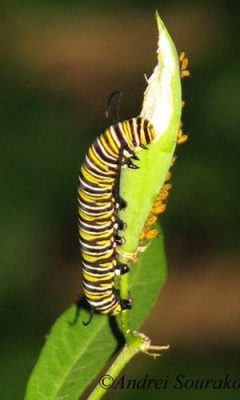The Monarch butterfly, Danaus plexippus, is the best known butterfly in North America. Monarchs found in North America can be split into the eastern and western monarchs. Those which live and breed west of the Rocky Mountains spend their winters in southern California whereas those who live and breed in the east overwinter in Central Mexico. Monarchs can also be found in Hawaii, Australia, New Zealand, Portugal and Spain.
The orange-and-black warning coloration of monarchs is designed to warn predators that they are foul-tasting and toxic. They are poisonous as a result of their diet. Monarch caterpillars feed on milkweed which is toxic, and they are able to store the toxins into adulthood which protects them from birds.

The female monarch butterfly lays individual eggs on a milkweed plant (Asclepsias sp.). The eggs hatch into larvae or caterpillars in a few days, and the caterpillars spend the next two weeks eating milkweed. Development from egg to adult takes less than a month, and monarchs can have four generations before they start to migrate.

Monarch butterflies which are born in the spring or early summer will start to reproduce in a few days. Those born in summer or fall will plan to migrate to the south for warmer weather.
The adult monarchs are strong fliers. They can fly up to 11 continuous hours, and in the fall they have usually stored a sufficient amount of fat to allow a flight of over 600 miles per day. Monarchs feed substantially during their migratory flight so they can accumulate enough body fat to last them through the winter. They use the sun to stay on course and have a magnetic compass to help them navigate. When overwintering in Mexico or in California, the monarchs spend over four months in a reproductive diapause. Monarchs begin to fly north in March.
In the 1950’s F. A. Urquhart of the Royal Ontario Museum started a tagging program which is still in use today, and is helping scientists and the public learn more about monarch migration.

Black-beaked orioles and black-headed grosbeaks attack monarchs at their overwintering sites. The milkweed toxins in the monarchs apparently deteriorate during their migration so the birds can eat them. These two species of birds account for over 60% of the total monarch mortality.
Predators such as ants, spiders, and wasps attack monarch caterpillars on milkweed plants. Tachinid flies and braconid wasps can also parasitize and kill the caterpillars.
Conservation groups have petitioned the U.S. government, requesting that the monarch butterfly be listed as “threatened” under the Endangered Species Act. While no decision has been made, it’s clear that the number of monarch butterflies continues to decline. For example, western monarchs have declined by more than 99% since the 1980’s and eastern monarchs have declined by approximately 80%.
The disappearance of milkweed is a major reason for their population decline since milkweed is the only plant on which monarchs will lay their eggs, and it’s the only food the caterpillars will eat. The regular removal of milkweed from fields in recent years, as well as the increased use of herbicides along roadways has significantly reduced the amount of milkweed available.
Climate change is also a concern. Monarchs are very sensitive to temperature and weather changes which may affect their biological processes, such as knowing when to reproduce and when to migrate. We are also experiencing more extreme weather events which negatively affect their overwintering habitats and milkweed availability.
There are many efforts to protect their habitat, replenish milkweed, raise awareness, and gather new scientific evidence to better understand these butterflies.